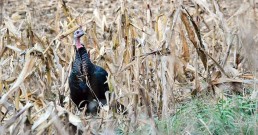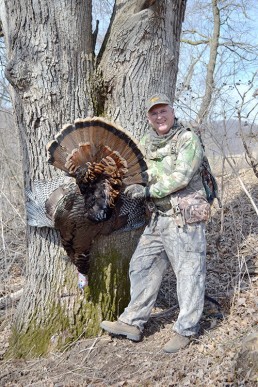Success in Dealing with a Tom with Hens
SHARE THIS POST
I was definitely in the camp that believed a tom with hens was a lost cause. Any place, anywhere, and any time I encountered a strutting tom with hens, my confidence immediately waned. My assumption stemmed from the obvious: Why would a gobbler be even remotely interested in my calls or decoys when he’s got a bona fide girlfriend standing right in front of him?
It’s hard to argue with such logic, yet a single hunt this past spring has me rethinking this supposition.
I was set up inside a pop-up blind overlooking a large crop valley surrounded by hardwood bluffs in Wisconsin’s Buffalo County on a typical crisp mid-April morning. The only thing atypical about this particular hunt was the remnant of snow on the shady sides of bluffs. Winter took a long time to say goodbye.
As dawn broke, several gobblers began to sound off on a distant bluff edge situated about 400 yards to the east. In between each burst of gobbling, faint yelps told me all I needed to know—a group of hens had roosted right next to these toms and their sweet voices were the reason for all the commotion. It sounded like an entire flock of turkeys had roosted on the far eastern corner of the valley.
Dawn’s first light revealed my pair of hen decoys positioned about 25 yards out in front of my blind. Any thought of moving closer to the gobbling at the far end of the valley was quickly thwarted by the louder yelp of a lone hen perched on a ridge just 75 yards north of me. She was now responding to those distant yelps and mimicking them vigorously. I decided to join in with my own “girl talk” on a favorite aluminum slate that worked particularly well on damp early mornings. My goal was to become part of this noisy back-and-forth banter in the hopes that this lone hen would fly off her roost and drop in for a closer look (at my decoy setup).
After a few successful trades back and forth, the nearby hen suddenly went quiet; I assumed she had flown off toward the rest of the flock. But then she suddenly popped out at the field edge directly across from my setup. As soon as she spotted my pair of feeding hen dekes, she began to approach while occasionally yelping and purring. I immediately answered her in a mimicking manner. This has been a trick I used successfully many times on past hunts, and it worked once again. She immediately became agitated by the echo calling, and responded with louder yelps.
Surprisingly, this fired up all those birds roosted way to the east of me as they pitched out into the field immediately below their roosting trees. Eventually, I made out at least four hens and three toms in this group. One hen from this harem began a loud, raspy yelping sequence that really fired up the toms and they began gobbling more intensely as well as strutting anxiously in circles. I no longer had to do any calling at all. The hen close to me began to respond to that same raspy yelp from the long-range bossy hen with a raspy-like version of her own. It began to sound like a NWTF Turkey Calling Convention of sorts.
Are you enjoying this post?
You can be among the first to get the latest info on where to go, what to use and how to use it!
The three distant toms never showed much interest in the hen close to me. Instead, they were dialed in on the girls right in front of them and were particularly interested in the raspy mama. However, that all suddenly changed when a group of five jakes arrived out of nowhere from west of my blind. As soon as those jakes saw my decoy set and the live hen nearby, they all closed in and began to court the hen as well as my dekes. This immediately changed the attitude of those toms strutting a good 400 yards from, as well as the harem of hens with them. Before I could really decipher what was really unfolding around me, the raspy mama made a beeline for my setup—the rest of the flock followed.
I had to chuckle as the three gobblers waddled in and out of strut while trying to run and catch up with the lead hen. As fast as big gobblers can run under normal conditions, they can sure look clumsy when desperately trying to show off their plumage in a puffed-out strut while attempting to keep up with a fast- moving hen. I immediately thought they looked more like The Three Stooges than wild, mature male turkeys. Even with all the stumbling and waddling, they’d crossed that big field of corn stubble in short order. While they were initially over 400 yards out, they had now all closed inside of 75 yards.
It is moments like this that make me wish I had a videographer sitting next to me recording the whole thing. There was so much going on now so fast with so many different birds that it was hard to keep track of it all. Instead, I just concentrated on the longbeards. The most dominant of the three simply couldn’t help himself and he quickly moved in on those jakes to chase ‘em away from my dekes and the hens feeding right next to them. Of course, there were so many birds together at close range now that I couldn’t shoot until there was some separation.
I finally noticed an insubordinate tom strutting by himself off to one side of the group, isolated from the rest. This made him a logical choice for a load of 12-gauge, 3 1/2-inch Hevi Shot, and I beaded down on him and my hunt was over.
Or so I thought. What followed was perhaps the most intense part of the whole ordeal as my target tom, now doing that final death flop, was suddenly attacked by all four jakes! Like I said, I sure wish I had a videographer with me at moments like these. I sat in my blind for at least another five minutes watching the whole fiasco before unzipping the blind and retrieving my kill.
Obviously, I will no longer look at a tom with hens the same way. Rarely are events in the outdoors predictable, and this was a classic case in point in this regard. Never assume that a tom with hens is a waste of time. The sudden appearance of a rival can be a game-changer—literally.
MWO
SHARE THIS POST
Did you enjoy this post?
You can be among the first to get the latest info on where to go, what to use and how to use it!
Joe Bucher
Joe Bucher is a Freshwater Fishing Hall of Fame Legendary Angler, book author, lure designer and host of Fishing with Joe Bucher TV series.



